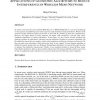Free Online Productivity Tools
i2Speak
i2Symbol
i2OCR
iTex2Img
iWeb2Print
iWeb2Shot
i2Type
iPdf2Split
iPdf2Merge
i2Bopomofo
i2Arabic
i2Style
i2Image
i2PDF
iLatex2Rtf
Sci2ools
129
click to vote
CORR
2010
Springer
2010
Springer
Applications of Geometric Algorithms to Reduce Interference in Wireless Mesh Network
In wireless mesh networks such as WLAN (IEEE 802.11s) or WMAN (IEEE 802.11), each node should help to relay packets of neighboring nodes toward gateway using multi-hop routing mechanisms. Wireless mesh networks usually intensively deploy mesh nodes to deal with the problem of dead spot communication. However, the higher density of nodes deployed, the higher radio interference occurred. This causes significant degradation of system performance. In this paper, we first convert network problems into geometry problems in graph theory, and then solve the interference problem by geometric algorithms. We first define line intersection in a graph to reflect radio interference problem in a wireless mesh network. We then use plan sweep algorithm to find intersection lines, if any; employ Voronoi diagram algorithm to delimit the regions among nodes; use Delaunay Triangulation algorithm to reconstruct the graph in order to minimize the interference among nodes. Finally, we use standard deviation ...
Related Content
| Added | 01 Feb 2011 |
| Updated | 01 Feb 2011 |
| Type | Journal |
| Year | 2010 |
| Where | CORR |
| Authors | Hung-Chin Jang |
Comments (0)

